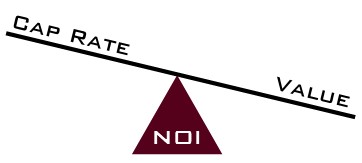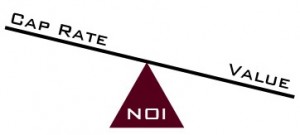The capitalization rate is a fundamental concept in the commercial real estate industry. However, it is often misunderstood, even by those within the industry. My goal is to give you a solid understanding of the concept of a cap rate and to explain when this tool is useful, and when it is not.
Mathematically, the capitalization rate (or CAP rate) is the Net Operating Income divided by the Value.
CAP = Net Operating Income
RATE Value
For example, if a property was listed for $750,000 and generates $75,000 per year in net operating income (NOI), then the cap rate would be 10%. As one of my favorite instructors Mr. Joe Still, CREA, ,CPN, CCIM pointed out… the cap rate is a lie (NOI) divided by a fantasy (Seller’s Asking Price). So, what does this really mean?
Since the cap rate and value are inversely related, as the cap rate goes up, the price or value or a property goes down. One way to think about cap rate is that this represents the percentage return or dividend that an investor would receive on an all cash purchase. Or, if you are comfortable with the stock market, the cap rate is the inverse of the price/earnings multiple.
One important item to point out is that, just like any investment, typically the higher the return or cap rate, the higher the risk involved. Also, remember the NOI? The cap rate does NOT factor in any type of financing or mortgage payments. The net operating income line is above the debt service or mortgage and interest portion in your cash flows.
The cap rate can be very useful when valuing commercial real estate in several scenarios. It allows you to quickly compare acquisitions relative to other potential investment properties. If you were considering a property with a 6% cap rate and another with a 14% cap rate, you should recognize immediately that one of these properties has a higher risk premium associated with it. That may be a good thing, or may not, depending on the rest of the circumstances.
In my opinion, the cap rates should be based on a closed sales price, not just on what a property was listed for. By looking at trends of sub-markets with closed sales over the past few years, you can see based on cap rates where a market is headed. For example, if cap rates are compressing, that means values are being bid up and the market is heating up, and vice versa. Then, you can research further to determine why and if you think this trend is sustainable.
Despite the speed of using cap rates, there are a few draw backs. Remember the formula for a cap rate? NOI divided by Value? Well, that net operating income is on a single year’s performance, not on the whole picture. If a property is stabilized and performing well, the cap rate can be a great tool to compare values on the surface… but it’s for a single year.
What happens if the property has varying cash flows or will require substantial rehabilitation or releasing? Anytime you are dealing with a property that has irregular cash flows or a complex income stream, the only way to yield a credible and reliable valuation is from the internal rate of return, or IRR, with a full discounted cash flow analysis. You can also build in your own required returns with the cap rate through the Band of Investment Method, but we will cover that later in another post.
Commercial real estate is a multi-layered process. While it can begin with simple tools, such as a cap rate, it quickly evolves into complex cash flow analysis, before and after tax scenarios, and other economic influences and indicators.
If you need help building an accurate projection, give me a call (206) 293-1005. I’ll be happy to help you dig into a project and determine the best way to approach it.



Best explanation of CAP rates I’ve heard…ever! Thank you!
Wow. Thank you Sara!